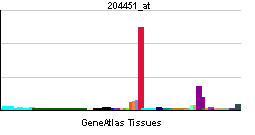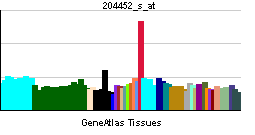FZD1
| Frizzled homolog 1 (Drosophila) | |||||||||||
|---|---|---|---|---|---|---|---|---|---|---|---|
| Identifiers | |||||||||||
| Symbols | FZD1 ; DKFZp564G072 | ||||||||||
| External IDs | Template:OMIM5 Template:MGI HomoloGene: 20750 | ||||||||||
| |||||||||||
| RNA expression pattern | |||||||||||
 | |||||||||||
 | |||||||||||
| More reference expression data | |||||||||||
| Orthologs | |||||||||||
| Template:GNF Ortholog box | |||||||||||
| Species | Human | Mouse | |||||||||
| Entrez | n/a | n/a | |||||||||
| Ensembl | n/a | n/a | |||||||||
| UniProt | n/a | n/a | |||||||||
| RefSeq (mRNA) | n/a | n/a | |||||||||
| RefSeq (protein) | n/a | n/a | |||||||||
| Location (UCSC) | n/a | n/a | |||||||||
| PubMed search | n/a | n/a | |||||||||
Frizzled homolog 1 (Drosophila), also known as FZD1, is a human gene.[1]
Members of the 'frizzled' gene family encode 7-transmembrane domain proteins that are receptors for Wnt signaling proteins. The FZD1 protein contains a signal peptide, a cysteine-rich domain in the N-terminal extracellular region, 7 transmembrane domains, and a C-terminal PDZ domain-binding motif. The FZD1 transcript is expressed in various tissues.[1]
See also
References
Further reading
- Tanaka S, Akiyoshi T, Mori M; et al. (1998). "A novel frizzled gene identified in human esophageal carcinoma mediates APC/beta-catenin signals". Proc. Natl. Acad. Sci. U.S.A. 95 (17): 10164–9. PMID 9707618.
- Sagara N, Toda G, Hirai M; et al. (1998). "Molecular cloning, differential expression, and chromosomal localization of human frizzled-1, frizzled-2, and frizzled-7". Biochem. Biophys. Res. Commun. 252 (1): 117–22. doi:10.1006/bbrc.1998.9607. PMID 9813155.
- Gazit A, Yaniv A, Bafico A; et al. (1999). "Human frizzled 1 interacts with transforming Wnts to transduce a TCF dependent transcriptional response". Oncogene. 18 (44): 5959–66. doi:10.1038/sj.onc.1202985. PMID 10557084.
- DeCostanzo AJ, Huang XP, Wang HY, Malbon CC (2002). "The Frizzled-1/(beta(2))-adrenergic receptor chimera: pharmacological properties of a unique G protein-linked receptor". Naunyn Schmiedebergs Arch. Pharmacol. 365 (5): 341–8. doi:10.1007/s00210-002-0540-3. PMID 12012019.
- Hering H, Sheng M (2002). "Direct interaction of Frizzled-1, -2, -4, and -7 with PDZ domains of PSD-95". FEBS Lett. 521 (1–3): 185–9. PMID 12067714.
- Strausberg RL, Feingold EA, Grouse LH; et al. (2003). "Generation and initial analysis of more than 15,000 full-length human and mouse cDNA sequences". Proc. Natl. Acad. Sci. U.S.A. 99 (26): 16899–903. doi:10.1073/pnas.242603899. PMID 12477932.
- Scherer SW, Cheung J, MacDonald JR; et al. (2003). "Human chromosome 7: DNA sequence and biology". Science. 300 (5620): 767–72. doi:10.1126/science.1083423. PMID 12690205.
- Hillier LW, Fulton RS, Fulton LA; et al. (2003). "The DNA sequence of human chromosome 7". Nature. 424 (6945): 157–64. doi:10.1038/nature01782. PMID 12853948.
- Zilberberg A, Yaniv A, Gazit A (2004). "The low density lipoprotein receptor-1, LRP1, interacts with the human frizzled-1 (HFz1) and down-regulates the canonical Wnt signaling pathway". J. Biol. Chem. 279 (17): 17535–42. doi:10.1074/jbc.M311292200. PMID 14739301.
- Wu J, Klein TJ, Mlodzik M (2006). "Subcellular localization of frizzled receptors, mediated by their cytoplasmic tails, regulates signaling pathway specificity". PLoS Biol. 2 (7): E158. doi:10.1371/journal.pbio.0020158. PMID 15252441.
- Omoto S, Hayashi T, Kitahara K; et al. (2004). "Autosomal dominant familial exudative vitreoretinopathy in two Japanese families with FZD4 mutations (H69Y and C181R)". Ophthalmic Genet. 25 (2): 81–90. doi:10.1080/13816810490514270. PMID 15370539.
- Gerhard DS, Wagner L, Feingold EA; et al. (2004). "The status, quality, and expansion of the NIH full-length cDNA project: the Mammalian Gene Collection (MGC)". Genome Res. 14 (10B): 2121–7. doi:10.1101/gr.2596504. PMID 15489334.
- Yang L, Yamasaki K, Shirakata Y; et al. (2006). "Bone morphogenetic protein-2 modulates Wnt and frizzled expression and enhances the canonical pathway of Wnt signaling in normal keratinocytes". J. Dermatol. Sci. 42 (2): 111–9. doi:10.1016/j.jdermsci.2005.12.011. PMID 16442268.
This article incorporates text from the United States National Library of Medicine, which is in the public domain.